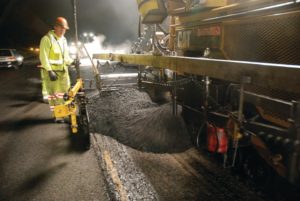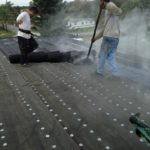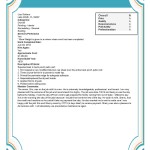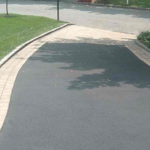Warm-Mix Asphalt Pavement Method
 Warm-mix asphalt is the generic name of technologies that allow the producers of hot-mix asphaltpavement material to lower the temperatures at which the material is mixed and placed on the road. Reductions of 50 to 100 degrees Fahrenheit have been documented. Such drastic reductions have the obvious benefits of cutting fuel consumption and decreasing the production of greenhouse gases. Engineering and construction benefits include better compaction of pavements; the ability to pave at lower temperatures, extending the paving season; improving working conditions by reducing exposure to fuel emissions, fumes, and odors and the potential to be able to recycle at higher rates.
Warm-mix asphalt is the generic name of technologies that allow the producers of hot-mix asphaltpavement material to lower the temperatures at which the material is mixed and placed on the road. Reductions of 50 to 100 degrees Fahrenheit have been documented. Such drastic reductions have the obvious benefits of cutting fuel consumption and decreasing the production of greenhouse gases. Engineering and construction benefits include better compaction of pavements; the ability to pave at lower temperatures, extending the paving season; improving working conditions by reducing exposure to fuel emissions, fumes, and odors and the potential to be able to recycle at higher rates.
Asphalt Pavement Method
In the general practice, it is known to use the hot mix asphalt, which it is the traditional process for constructing asphalt pavements. Hot mixed asphalt is manufactured in a central mixing facility (typically called a hot mix plant) and consists of high-quality aggregate and asphalt cement. The two are heated and mixed while hot to completely coat the aggregate with asphalt cement. The aggregates and asphalt cement are heated to above 300°F during mixing and kept hot during transport by truck, placement (where it is spread on the roadway by an asphalt paving machine), and compaction (where it is compacted by a series of asphalt roller machines) of the asphalt mixture. The mixture cools after compaction to form the asphalt pavement.
In the warm-mix asphalt production method, it uses temperatures 30°F to 120°F lower than traditional hot mixed asphalt. Less fuel is needed to produce warm-mix asphalt because less energy is needed to heat the asphalt mix. Fuel consumption during warm-mix asphalt manufacturing is typically reduced by 20 percent.
In paving projects, the greater the temperature difference between the asphalt mix and the outside temperature, the faster the mix cools. Since faster cooling effects durability, cold ambient temperatures adversely affect hot mixed asphalt. Relative to hot mixed asphalt, warm-mix asphalt cools more slowly, allowing warm-mix asphalt to be successfully placed in lower temperatures. As a result, warm-mix asphalt extends the paving season. It also makes night paving more feasible.
Additionally, warm-mix asphalt saves time in production as well as in surfacing roads. Cost savings are achieved by reducing time and labor spent compacting the mix because warm-mix asphalt makes compaction easier. This also allows reducing transportation costs. Lower temperatures also permit more asphalt mix to be hauled for longer distances.
There are many different technologies that have been developed to produce warm-mix asphalt, some of which are plant modifications, while others are additives to the mix and/or asphalt binder. The “foaming process” is the most common type of warm-mix asphalt plant modification technology, where a small, controlled amount of water is injected into the hot asphalt binder as it is mixed with the aggregate particles. The hot binder turns the water to steam which in turn causes the asphalt binder to expand rapidly into the foam (much like pressing the button on a can of shaving cream). The 16-fold binder volume increase results in the appearance and properties of “over asphalting” the mix, which facilitates placement and compaction. This binder volume increase remains until the temperature drops below the boiling point of water, causing the steam bubbles to collapse and the mix to set.
The warm-mix asphalt can also be produced by the addition of specially-developed additives, many of which reduce the thickness of the asphalt binder so that asphalt aggregates can be coated at lower temperatures. Others hold internal moisture and achieve the same type of foaming action as the plant modifications mentioned above. These additives can be introduced at the asphalt plant or purchased from the binder supplier already in the binder. The key is the addition of additives -such as water-based, organic, chemical, or hybrids- to the asphalt mix. The additives allow the asphalt binders and asphalt aggregates to be mixed at the lower temperatures. Reducing the viscosity also makes the mixture easier to manipulate and compact at the lower temperature.
It is also possible to combine different warm-mix asphalt technologies for enhanced performance. For example, many asphalt plants equipped with foam systems also use chemical warm-mix asphalt additives for even greater temperature reductions, compaction aid, and anti-strip treatment.
Introduced in Europe in 1997 and in the US in 2002, warm-mix asphalt is rapidly gaining acceptance. The warm-mix asphalt is a green product that lowers manufacture and lay down temperatures by 30° to 100°F. By reducing the temperatures, warm-mix asphalt doesn’t need as much energy to produce. It’s been documented to lower energy costs by 30-60%. The warm-mix asphalt reduces greenhouse gas and hydrocarbon emissions from the manufacture and construction of asphalt pavements. In addition to that, the lower temperatures make it safer for workers in the plant and at your asphalt paving project job site. The warm-mix asphalt has been especially successful in areas where air quality has been a problem in nonattainment areas.
Contact us
 Phone Call |
 Text Message |
 |






